The Cooperative Participatory Evaluation of Renewable Technologies on Ecosystem Services (CORPORATES): Scottish Marine and Freshwater Science Vol 7 No 1
This report provides the background, the process and the outcomes of an interdisciplinary project entitled “The Cooperative Participatory Evaluation of Renewable Technologies on Ecosystem Services: CORPORATES”, funded by the UK Natural Environment Resear
2 Process: Workshops
This section provides details for the two workshops including: (i) objectives; (ii) structure of the individual components; (iii) outcomes; and (iv) evaluations. Given the considerable effort that goes into design of a workshop, particularly when a new process is being developed, we offer a comprehensive account in an effort to facilitate future use of the process piloted in this project.
Both workshops consisted of a mix of knowledge exchange presentations and focused activities. The project team held multiple full day meetings and utilised shared online platforms for iterative discussion to clarify what was to be achieved and to develop the individual components. There was at least some degree of 'practice' for each component whereby content, flow, logistics for exchange and recording of information, room and seating arrangement, materials ( e.g. maps, markers) and make-up and size of groups ( e.g. small/large, sector specific/mixed) were considered. A facilitator and scribe were incorporated into each working group; each activity had an overall facilitator and time-keeper.
2.1 Workshop 1
The focus of the first workshop was to provide a forum through which sectoral groups could contribute their own knowledge about activities and important locations in the case study site to the existing body of scientific information (Exercise WS1-1a & WS1-1b); to identify benefits (Exercise WS1-2a & WS1-2b) and exchange insights and knowledge across sectors about these benefits (Exercise WS 1-3a); to examine linkages between benefits and ES (Exercise WS 1-3b); and to explore possible effects on these activities and benefits that might occur through windfarm developments, MPAs and climate change (Exercise WS 1-3c).
The specific objectives were:
- Develop understanding between the range of stakeholders and to allow a sharing of experiences in how stakeholders evaluate the range of important ecological, economic and cultural/social benefits and services ( i.e. the food, recreation and energy resources which together are called the ES) that the Firth of Forth provides
- Map uses / activities and associated benefits / filling data-gaps around recreational values & activities
- Develop an understanding on how different ES, activities and uses relate to components of biodiversity of the Firth of Forth
- Facilitate interactions between different stakeholders to determine potential trade-offs between different ES
- Evaluate the workshop as part of a model for future Marine Planning participatory evaluations
The workshop commenced with a project overview (please see all presentations on www.corporatesproject.co.uk) including knowledge exchange presentations, one from Windfarm developers and the other from Ian Davies ( MSS) and Roger May ( MS). These presentations sought to 'set the stage' for the project and clarify the current situation for consenting issues before proceeding to use the Firth of Forth and Tay region for this pilot study.
2.1.1 Exercise WS1-1: Participatory Mapping
This first exercise clustered participants into sector/interest-specific groupings - Fishing & Maritime activity, Recreation & Tourism (including recreational fishers), Conservation, Heritage & Community - with the addition of a windfarm developer in each group. By having a within-sector discussion, and people of similar vested interest at the same table, we hoped that discussion would be easier to commence and go into greater detail for discussion and mapping of the important activities and locations in the region. The box below details the exercise's structure as a whole which consisted of two activities.
| Aim |
Explore the location and spatial footprint of local activities by sector. Mapping included identifying uses of the region, ground truthing and refining existing maps. While substantial data exist, the focus of the exercise was to increase discussion and awareness across participants and prepare for further mapping of benefits and interactions. |
|---|---|
| Materials |
Each group was provided a hard copy of 3x A0 admiralty chart showing the location of windfarm, cables sites and MPA designations along with supplementary A1 size maps of existing spatial information by sector. Additional existing data layers from National Marine Planning Interactive which can be found on the following link: www.gov.scot/Topics/marine/seamanagement/nmpihome ( NMPi-shown on laptops) were also provided. Participants were asked to review existing information, provide additional data and information on the intensity of use. |
Activity WS1-1a
Validating and mapping activities: Guided by a facilitator, each group mapped out spatial activities and sites of importance across the region (see Image 1). The following information was mapped for each group, with flexibility for additional sites to be added by users:
- Fishing and Maritime: key fishing grounds by species and gear type; seasonal sites; recreational fishing sites; coastal infrastructure; shipping and ferry routes, sea angling;
- Recreation & Tourism: kayaking small boat sailing sites and access points; key sailing and racing areas; dive sites; board sport areas; locations and tracks for wildlife tourism;
- Conservation, Heritage & Community Sites of cultural importance, sites of historical importance; areas for visual amenity and viewing; significant wrecks; sites of importance including and in addition to SPAs and SACs; other areas of ecological importance.
Activity WS1-1b
Intensity of activities: Where feasible participants were asked to identify the intensity of use for the activities. A standardised key was presented grading intensity of use from 1-5 ( i.e. infrequently to frequently).
During both activities, participants were encouraged to discuss issues around mapping and data as well as interaction between the activities. In addition, any issues of concern expressed over interactions with windfarms were captured on flip charts with a 'parking' system for issues not directly related to the activity at hand.
Image 2. Stakeholders incorporating their knowledge onto existing spatial information for the Firth of Forth region.
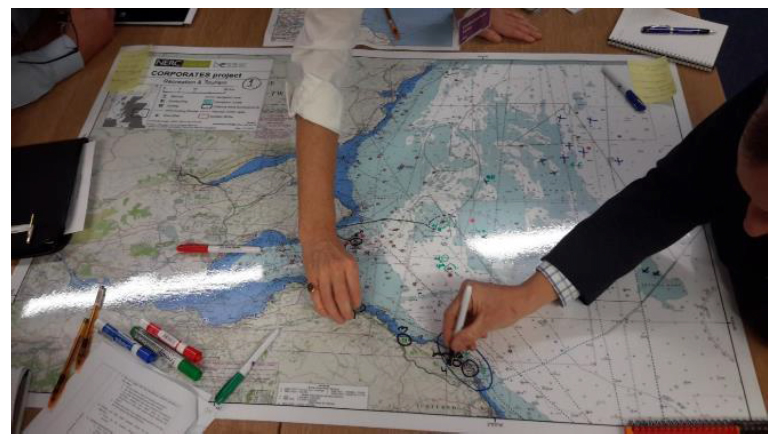
OUTCOMES: Exercise WS1-1 Participatory Mapping
The spatial data collected from Exercise WS1-1 were digitised using spatial mapping software ArcGIS. This created an electronic format of the spatial data which could then be added to the current database of knowledge of the Firth of Forth. An example map for the Fisheries sector is provided in Figure 3 which illustrates the new knowledge identified about activities in the area. Figure 4 shows the way in which both activity and intensity of activity were combined into a single digitized map through data provided by the Tourism & Recreation group. The map generated by the NGO & Ecology sector can be found in the discussion of outcomes for Exercise WS1-2 (Activity b and c) to illustrate the combined spatial maps created to capture activities, benefits and intensity into one digitised map.
The within-sector grouping generated very detailed maps and rich discussions on what may have been missing for various reasons from official maps and why it was important. Thus our hope that clustering people of similar vested interest could help facilitate conversation and deep engagement was very much supported and rewarded by the outcome of this exercise.
Figure 3. Fishing Sector Map. Representing information about commercially fished species that is not currently on the publicly available maps of scallop and nephrops fisheries.
(available at www.gov.scot/Topics/marine/science).
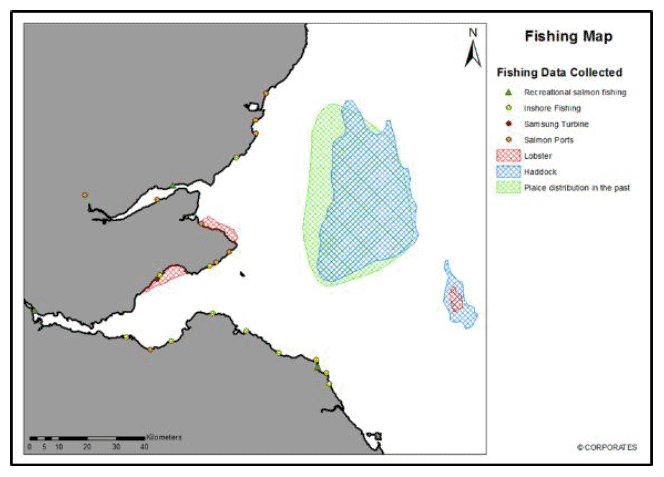
Figure 4. Recreation Sector Maps (combined groups) illustrating activity and intensity of use. [Note: importance of the area refers to data collected through Activity WS1-2 (Activities a and b).]
![Figure 4. Recreation Sector Maps (combined groups) illustrating activity and intensity of use. [Note: importance of the area refers to data collected through Activity WS1-2 (Activities a and b).] Figure 4. Recreation Sector Maps (combined groups) illustrating activity and intensity of use. [Note: importance of the area refers to data collected through Activity WS1-2 (Activities a and b).]](/binaries/content/gallery/publications/report/2016/02/cooperative-participatory-evaluation-renewable-technologies-ecosystem-services-corporates-scottish-marine/00493669.gif)
2.1.2 Exercise WS1-2: Benefits
The second exercise consisted of three activities which are detailed below. Participants remained in the same sector/interest-specific groupings as used in the first exercise.
| Aim |
Highlight the benefits local stakeholders are getting from marine activities |
|---|---|
| Materials |
Each participant recorded their benefits on post-it notes. The post-it notes were then placed on a flipchart. Sticky dots were used to mark specific locations on the map. |
Activity WS1-2a
Benefits identification. Participants were asked to individually write benefits linked to their sector-specific activity on post-it notes. Benefits are defined as important ecological, economic and cultural/social benefits and services ( i.e. the food, recreation and energy resources which together are called the ES) that the Firth of Forth provides. The activity was described as one which drew on the previous Exercise with a focus on benefits rather than specific activities. Facilitators introduced the activity using the following guiding language:
"In the previous exercise you indicated on the map where you do what. Now we would like you to think about and write down the benefits that those activities provide either for your particular interest, for society as a whole, or for biodiversity. These can be material benefits but they can also be non-material things."
Participants were then asked to share their identified benefits with the others at the table. The post-it notes were then placed on a flip chart and grouped according to activities; a process that was stakeholder led. After having heard and worked through the initially identified benefits, participants were given opportunity to add further benefits. We used a pre-prepared 'check-list' of benefits to prompt for additional benefits developed from existing literature ( e.g. Irvine et al 2013). An example prompt provided to facilitators was:
"You haven't mentioned anything about sense of place. Is fishing important with regard to what people see as being characteristic or being an important part of what makes up the of the Firth of Forth?"
OUTCOME of Activity WS1-2a
The lists of benefits identified by each sector table were rapidly compiled (over lunch) into a combined set of benefits, by sector, for use in Exercise WS1-3a. The benefits were more carefully arranged into categories when the research team undertook further analysis in between the two workshops for additional use in Workshop 2 - see the Section Grouping of Benefits
Activity WS1-2b
Location of specific benefits. Participants were asked to identify which - if any - of the benefits linked to particular spatial locations and or habitats. These were marked with numbered sticky dots on the maps and the reason - e.g. what are the particular characteristics of those locations that the benefits depend on - was recorded on a flip chart. For example, a benefit might be associated with a specific location. As needed, facilitators prompted discussion with question such as: "Would you say that kayaking makes you feel relaxed no matter where you go or is it only when you go to particular places?"
Image 3. Stakeholders using sticky dots to record benefits that were linked to specific places.
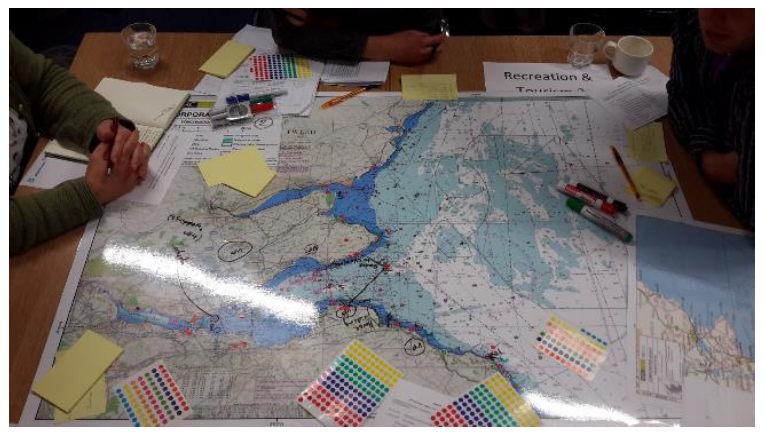
Activity WS1-2c
Importance of a location to specific benefits. Participants were asked to evaluate/weight different areas/locations (as 'low, medium, high' importance) according to the identified benefits.
Example of question: "With regard to seeing wildlife, would you say that this area is of low, medium or high importance"
OUTCOME of Activity WS1-2b and c
Any information about the spatial location and the importance of location for specific benefits were combined with the spatial data about activities (from Exercise WS1-1) to create digitized, electronically available maps. Data about the location and intensity of activities (Exercise WS1-1), and the specificity and relative importance of particular places for benefits, were combined into a single representation for the NGO & Ecology sector group (Figure 5). The map presented in Figure 4 illustrates this for the Tourism & Recreation sector groups.
Figure 5. NGO, Ecology Sector Map (combined groups). Maps of seabirds ( JNCC ESAS http://jncc.defra.gov.uk/page-1547 ) and seals were already available to the groups http://www.gov.scot/Topics/marine/science/MSInteractive/Themes/seal-density
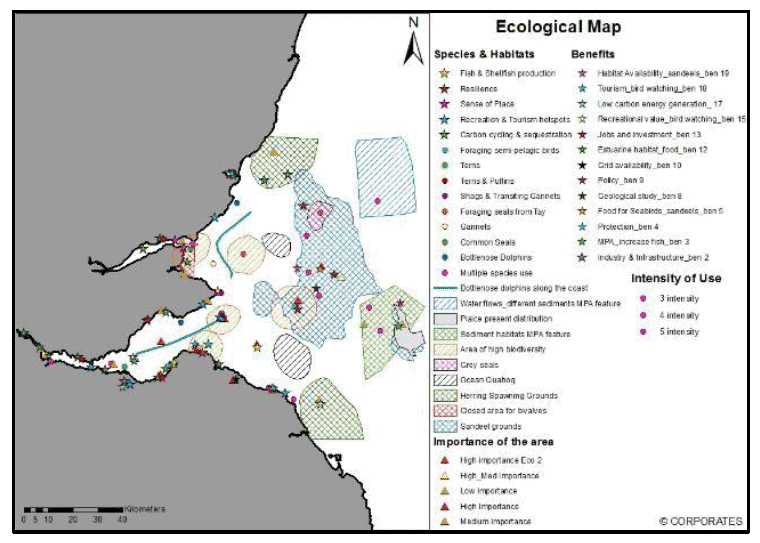
2.1.3 Ecological Interlude [see slides in www.corporatesproject.co.uk
Presentations provided basic background on how marine ecosystems function, the types of linkages between climate change, ecosystem function and the food web and how these linkages may operate in different locations. The premise of introducing some ecological background is that we believe that to better manage our oceans on an ecological basis it would be best if we all understood more about marine ecology.
Overview of Ecological Interlude session
- What may change with introduction of Windfarms, MPAs and Climate Change
- An example: Plankton biomass
- Building the Linkages
2.1.4 Exercise WS1- 3: Commonalities and Differences
This third exercise consisted of three activities focused on identifying, learning about and discussing similarities and differences between the sectors represented at the workshop. Participants had an opportunity before the exercise to view the maps of activities and spatially located benefits generated by all sector groups. Exercise WS1-3 was carried out in mixed sector groups. After having generated their own lists of perceived benefits, participants had an opportunity to view the maps of activities and spatially located benefits as well as read through the list of all benefits that had been generated by all sector groups.
| Aim |
To explore the links among local marine activities within all sectors, the benefits and the underlying natural (ecological) processes. Assist knowledge exchange between sectors. |
|---|---|
| Materials |
Scribes were issued with notebooks and a pen to record the discussions. A flip-chart and marker pens were used to record the main points of the discussion. |
Activity WS1-3a: Commonalities and differences between sectoral Benefits.
Participants were provided with a combined list of benefits by sector (generated from Activity WS1-2a) and asked to consider what similarities and or dissimilarities they observed across the benefits identified by different sectors. Participants were encouraged to 'unpack' and discuss these. Examples of questions asked by facilitators as starting points included:
a. What benefits are shared among the groups?
b. What was meant by each group for the benefits?
c. What are the differences?
Sub-Aim: To encourage the participants to think back to how their benefits, from their activities, rely on natural processes.
OUTCOMES: Activity WS1-3a: Commonalities and differences in benefits perceived by the different sectors
Commonalities in benefits that were noted included: food, employment, recreation, communities, connections with others, education, well-being, relaxation, enjoyment, calm, closeness to and appreciation of the intrinsic value of nature, fishing, and tourism. Not all these commonalities were noted by all groups; food and employment were two benefits that were identified as present for all sectors.
The disparities amongst benefits considered to be shared between sector groups seem in part to reflect differences in how narrowly or broadly the listed benefits were interpreted by the groups. For example, one group identified 'wellbeing' as a shared benefit yet not all groups had used that term, instead using terms such as 'feel good factor'. Interestingly, some sector groups included items/benefits in their list of shared benefits which had not been mentioned during the Benefits Identification activity ( WS1-2a). For example, a fisheries group identified 'relaxation' as a benefit common to all sectors despite not having included this amongst their own list of benefits. This may be reflective of a shift in perspective away from a sector specific focus to considerations at a broader scale.
Several sector groups reflected on the potential for synergies and conflicts amongst the different activities and/or benefits. Discussion highlighted the reality that these cannot always be seen as clear cut but rather are dependent on the particular circumstances or the ways in which things were implemented. Conservation and fishing, for example, were seen as being at odds in instances where fishing bans were introduced, but were also seen as sometimes having shared interests, such as when Marine Protected Areas helped conserve important spawning grounds for fish.
Activity WS1-3b: Linkage between benefits and the ecosystem
This activity specifically sought to examine the linkages between the identified benefits and the ES that provided them. Participants were asked to again review the full list of identified benefits from the region and discuss how they link back to natural (ecological) processes and the ecosystem. Participants were encouraged to consider both positive and negative linkages. Example questions asked by the facilitators include:
Please consider how:
a. Availability of prey for birds is linked to ES and underlying ecological processes
b. Wildlife watching is linked to underlying ecological processes e.g. key habitat sites; areas for foraging; food webs.
c. Availability of fish is linked to ecological processes e.g. availability of plankton; sea temperature; nursery sites.
Sub-Aim: To encourage the participants to consider the potential impact (positive or negative) of various types of change on the benefits they identified and the activities associated with them.
OUTCOMES: Activity WS1-3b: Linking benefits back to ecosystem processes
This second part of Exercise WS1-3 asked participants to consider how the benefits that had been identified were linked to ecological processes. The 'going backwards' from benefits to processes took quite some time and prompting to get started. It seemed to require a shift in thinking for most of the participants and appeared to be less intuitive than going the opposite way, as was done in the second workshop.
Several of the groups emphasised that not all of the listed benefits could in fact be linked back to ecological processes. An example given was that of the thrill of surfing. For some of the benefits, the links seemed easier to identify and more unequivocal than for others. For example, tourism that relied on the presence of charismatic animals such as puffins was linked back to the production of fish by several groups. Other connections were, however, seen as more ambivalent. One of the recreation groups, for example, mentioned that scuba diving could be both negatively and positively influenced by plankton production; increased plankton could mean lower visibility for divers yet it could also mean a greater abundance of marine animals to see when diving. An additional type of linkage noted was for benefits such as those provided by fishing; these were seen as interconnected to and with complex processes that could not be easily disentangled and described in an exercise such as this.
2.1.5 Activity WS1-3c: Impacts of changes to benefits and activities from Climate Change, Windfarms, Marine Protected Areas
This part of the exercise examined the possible effect of natural, man-made and policy generated change for the region. Participants were asked to consider the potential impact of various types of change, including climate change, windfarms, and MPAs, on the benefits identified and the activities associated with them. Discussion also included mitigation measures and other factors influential of change. Facilitators drew on the following example scenarios / issues for discussion:
a. Climate Change e.g. more frequent high intensity storms, sea level rise, sea level temperatures
b. Windfarms e.g. construction, interactions
c. Marine Protected Areas e.g. displacement of fisheries, overspill of animals into other areas; tourism opportunities.
OUTCOMES: Activity WS1-3c: Impacts of changes to benefits and activities from Climate Change, Windfarms, Marine Protected Areas
Discussion focused on possible mitigation measures and identification of any additional factors that might influence change. It took some time and prompting for most of the groups to start this discussion. This may reflect the challenge associated with moving from the abstract to the more specific, particularly when there has been little direct experience, e.g. of an MPA.
Unsurprisingly, each group identified both positive and negative impacts which cut across the different sectors, although there were some similarities across groups. For example, in discussion of MPAs, the restrictions or displacement of activities associated with fishing and recreation were commonly identified as potential negative impacts. A concomitant potential positive impact of increased species richness and abundance for these two sectors was commonly noted as well. The breadth of potential impacts identified is notable, taking into consideration not only individual sectors ( e.g. entanglement of fishing gear with undersea windfarm infrastructure) but also wider community and societal impacts. Examples of the latter include the potential loss of trust that could occur if the claimed environmental benefits of MPAs do not occur and the wider economic ( e.g. jobs) and social ( e.g. educational) benefits of windfarm development are not realised.
2.1.6 Workshop 1 Evaluation - Summary
Workshop evaluations sought to understand what learning might have taken place, to what extent new knowledge had been gained from the various activities, an assessment of the workshop structure ( e.g. materials, delivery, quality of discussion) and the overall experience of each workshop as a whole.
Feedback forms
Figure 6. The Percentage of participants that that either agreed or disagreed with the statement that they gained knowledge from each of the stated activities
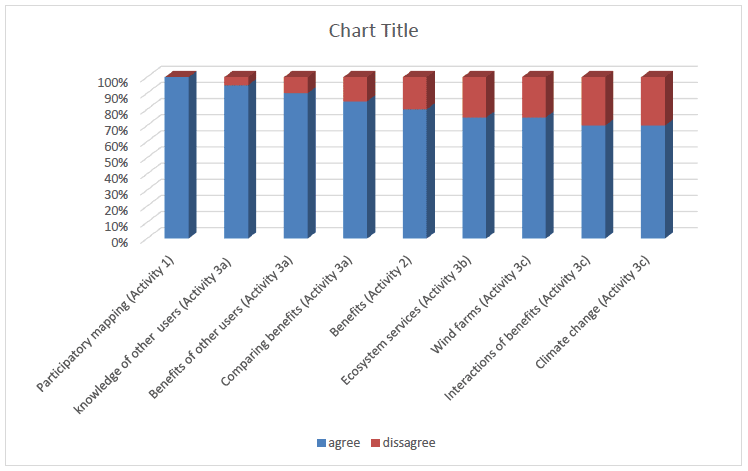
Figure 6 shows participants' assessment of knowledge gain about activities, benefits and ES and the extent to which specific activities might have facilitated learning. Participants were largely in agreement that they had learned something about the activities of and benefits gained by other users in the region. With respect to ES, there was greater divergence; responses from a quarter of the participants (5) suggested no new information had been gained about this topic. Written comments from several of these individuals, along with a review of the organisation to which these five individuals are affiliated, suggest that this may reflect a previously existing level of familiarity with the topic due, for example, to their current or previous work. The opportunity for reinforcement of this existing knowledge and for hearing other people's perspectives was noted as both appreciated and valuable.
With regard to specific workshop activities and the extent to which participants' felt they had learned something new from the activity, inclusion of this evaluative question was to serve two purposes: to gain insight into the effectiveness of the activity itself as one for facilitating knowledge exchange and into whether learning might have occurred. Results from these questions are also illustrated in Figure 6. As one might expect with a diverse set of stakeholders, there was a divergence of opinion although, overall, the evaluations show a high level of agreement/strong agreement that learning had occurred from the activities. This was particularly true for the participatory mapping (Exercise WS1-1) where all participants noted that they had learned something new from the activity. No specific comments were provided by participants as to why such an activity might facilitate new knowledge. A review of scribe notes taken during the activity suggests a breadth and depth of discussion was present within the sector groups as well as during the time that sector groups viewed one another's annotated maps. A reflective assessment of the activity by the project team noted the animated, candid and engaged level of exchange present during this activity.
The two activities which focused on benefits - identification of (Exercise WS1-2) and comparison between sector groups (Exercise WS1-3a) - received similar assessment in terms of learning with most participants indicating that they had gained new knowledge. With no specific comments as to what was valuable about these activities, it is difficult to tease out what aspects might or might not facilitate learning. Of those who disagreed, several of them were the same participants who had indicated minimal learning about ES, and so there may have been a degree of familiarity present for benefits from ES as well. One participant noted surprise that benefits had featured so early in the workshop while another commented on the difficulty of parsing the large number of benefits that had been identified in Exercise WS1-2a in order to meaningfully compare across sectors. This latter observation was also raised during the project team's reflective assessment which also noted that the process of locating benefits on the map and ranking their importance posed challenges, particularly for benefits that were spatially distributed and/ or whose importance varied temporally, e.g. weather, season.
The final three activities sought to explore linkages among benefits, activities and ecological processes (Exercise WS1-3b) along with potential impacts of various drivers of change, specifically climate change, windfarm development and MPAs (Exercise WS1-3c). Roughly two-thirds of the participants agreed that they had learned something from these. The only specific comment provided as to why these might have facilitated learning was the participant who noted that '[it was] helpful to gain better understanding of links'. For those who did not gain new insight, the level of previous knowledge again appears as a factor with several individuals noting an existing awareness of and indeed immersion in the interactions and issues explored in these activities. For example, in relation to MPAs, one participant noted: '[I] would have ticked agree if the option were extended to [learning about] views of local stakeholders' going on to explain that the principles of MPAs, multi-use, non-use were not new to them thus '[I] couldn't absolutely say learnt 'new' information'. Two comments shed light on how the design of the activity might have impacted learning. One person noted their disagreement with having learned something from the exploration of interactions was 'only because [there were] too many parts to consider'. This sentiment was echoed by another participant who noted that the 'interactive task was muddled, partly due to the enormity of the task'. During the project team's reflective process, there was a general agreement that these activities were trying to cover too much ground in too short a period of time.
Figure 7. Quality of the workshop 1 / out of 1.0
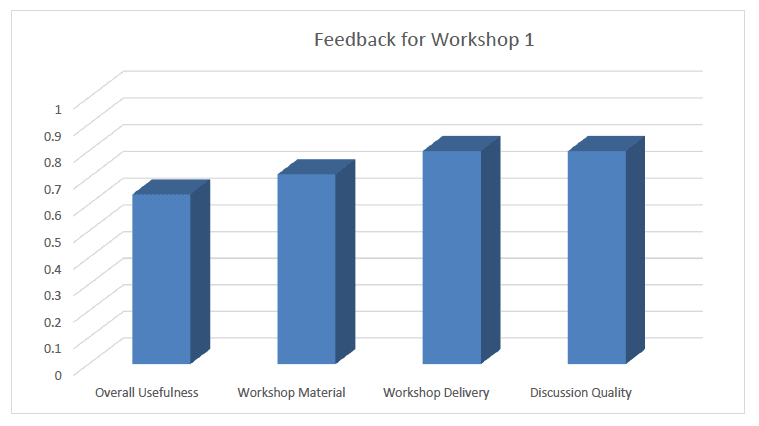
Evaluations of the workshop as a whole were positive (Figure 7). Half the participants considered it useful or very useful (the remaining indicated it was somewhat useful); the vast majority (18 out of 20) evaluated both the delivery and materials as 'above average' with one individual noting it would have been valuable to receive some materials or an outline of activities in advance.
Almost all (17 of 20) evaluated the quality of discussion as above average (the remaining considered it average) and all but one felt they had been able to contribute knowledge to the discussions (no comment was provided as to why).
Comments about the quality of discussion and the workshop in general highlight the value of (re)meeting and learning from and about other stakeholders' perspectives, the challenge of applying ideas and moving discussion to implementation and the opportunity for identifying common ground as well as gaining new insight (see Table 2 for examples).
Table 3. Some example comments from Stakeholders regarding different aspects of the workshop.
| Meeting people, learning from & about others |
|---|
| Useful to meet stakeholders of the region although we knew a lot of them Useful to meet people and for different stakeholders to understand each other's drivers / concerns |
| Quality of discussion |
| Found more common interests with 'other' user interests than expected Very positive afternoon discussions - candid, constructive and in good spirit |
| Application of material from workshop |
| Some interesting and useful discussions but relatively little that was original / unique. Some new information may have been gathered and the discussions may have been novel to some of the participants but it is difficult to imagine how outputs will be used Feels a little bit of a talking shop with no real insight or direction as to how it may be developed or implemented in terms of the ecosystem approach |
| New insight |
| I hadn't thought of impact assessment this way before. Very thought provoking |
2.2 Analysis and construction between Workshops
Considerable analysis and planning took place between workshops in order to review and prepare the rich information provided by stakeholders for use in the second workshop. The CORPORATES research team held multiple meetings to review and discuss which aspects of activities worked well and which did not, such that we could revise and construct the strategies for the second workshop (See Figure 1 and Table 2). The following sections detail work undertaken in preparation for Workshop 2.
2.2.1 Grouping of Benefits Exercise WS1-2: Benefits
Over 100 different Benefits were identified by the stakeholders in Workshop 1 (see Table 1 in the Appendix for a list of all the Benefits). The approach taken in the first workshop - to collate and summarize the large number of benefits identified in the morning (Activity WS1-2a) during the lunch break for use in afternoon - was, while heroic, too ambitious. Given the volume of information, both facilitators and participants simply did not have enough time to absorb and summarize the information in a way to make it fully useful in the afternoon discussions. Therefore one of the clear recommendations of this process is that a second workshop is needed some time after the first; the discussion section of this report provides guidance as to how long a period might be needed between the two workshops.
To reduce the large number of identified Benefits into a fewer number of categories, the research team undertook an iterative discursive process. An initial set of categories were identified followed by discussion (using face-to-face and online platforms for dialogue) to reach agreement on both the meaning of overall category terms and a final set of 12 categories. (Table 4). The 12 categories were used to design Exercise 1 in Workshop 2 (for further information on their use in workshop 2 see section Exercise WS2-1.
Table 4. Summative set of twelve categories of benefits derived from participant generated benefits from ES in the Firth of Forth, Scotland.
| B1 Local Economic Benefit |
B7 Escape |
| B2 Employment |
B8 Health |
| B3 Cultural Heritage |
B9 Adventure and challenge |
| B4 Social Bonding |
B10 Knowledge and skills |
| B5 Healthy Climate |
B11 Connection to Nature |
| B6 Ecosystem Health and Resilience |
B12 Aesthetics and Scenery |
The 12 categories of benefits were further summarised to four benefit domains which were also used in the second workshop, specifically Exercise WS2-2. The categories were combined to form the domains in the following way:
- Local Economic Benefits (made up of B1 and B2)
- Cultural Heritage (made up of B3 and B4)
- Ecosystem Health and Resilience (made up of B5 and B6)
- Personal Wellbeing from Nature (made up of B7-B12)
Figure 8. Diagram showing how the benefits were grouped under 4 domains; Local Economic Benefits, Cultural Heritage & Identity which includes Social Bonding, Ecosystem Health & Resilience and Personal Wellbeing from Nature.
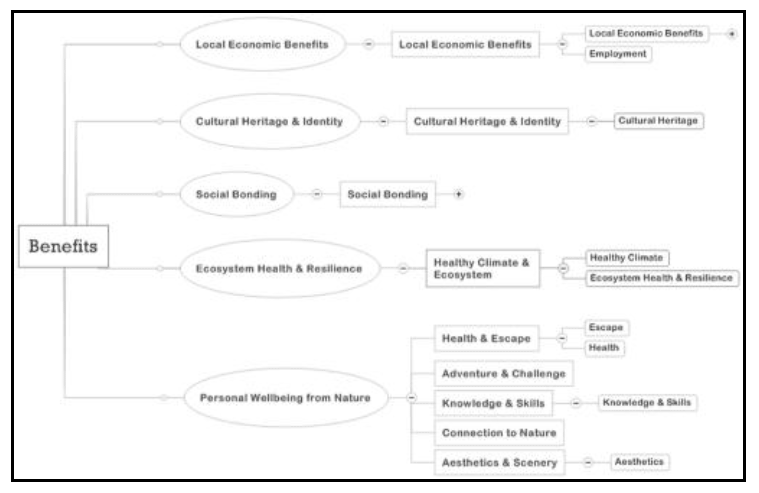
The agreed definitions of the set of 12 and set of 4 categories were defined using a range of sources that included international United Nations Educational Scientific and Cultural Organisation ( UNESCO, www.unesco.org), Wikipedia ( www.wikipedia.org) and national level guidance; UK National Ecosystem Assessment (Follow-on) UK NEAFO (Church et al, 2014; Turner et al 2014).
2.2.2 Assessing how different stakeholder groups valued different Benefits.
During Exercise WS1-2, we kept track of which sector suggested each benefit. Once agreement had been reached on categories and domains of benefits, we sought to understand the importance of the different benefits to each sector. Figure 9 illustrates the relative interest that sectors had within the 4 benefit domains; this information was shared with Stakeholders at the start of the second workshop.
Stakeholders were clustered into the following sectors: Fishing/Maritime, Renewables, Recreation & Tourism, Conservation & Ecological (Human) and Conservation & Ecological (Animal). The sub-categories within the Conservation & Ecological sector indicates that the benefits were identified from the same conservation groups but differentiated as benefits directly to humans or directly to animals.
Figure 9. Pie charts showing the number of benefits, in percentage, that each sector group identified. The percentages have been corrected for the number of people in the room of each sector group.
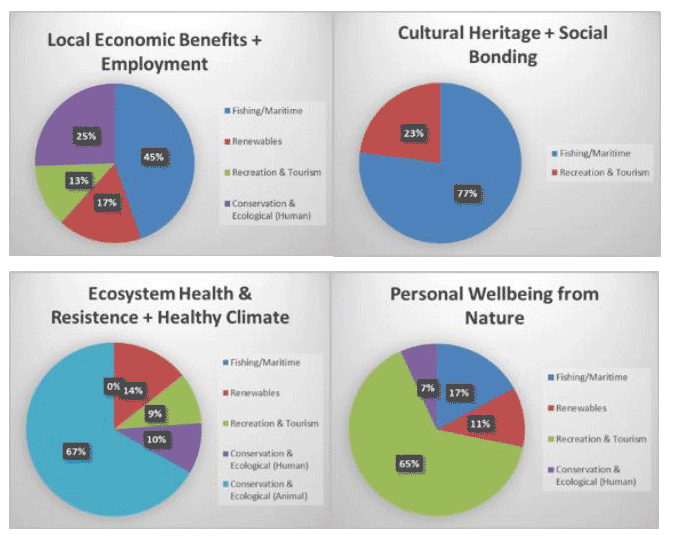
2.2.3 Identifying local ecosystem services for Workshop 2
We used the UK National Ecosystem Assessment Follow-On (Figure 10) to define what terminology we would use for ES in Workshop 2 Exercise WS2-2. The UK NEAFO document provides guidance on dealing with the definitions of Ecosystems and has marine examples as well as definitions of intermediate services. We identified 3 main ES of importance for this area and they were:
1. Fish and Shellfish,
2. Climate Regulation,
3. Places and Seascapes: with 4 Features
a. Degree of naturalness, wildness and vastness,
b. Habitat diversity,
c. Species diversity
d. Number of cultural/historical features
Figure 10. The classification of ES and goods and benefits for coastal and marine ecosystems for the UK NEAFO. (Turner et al. 2014).
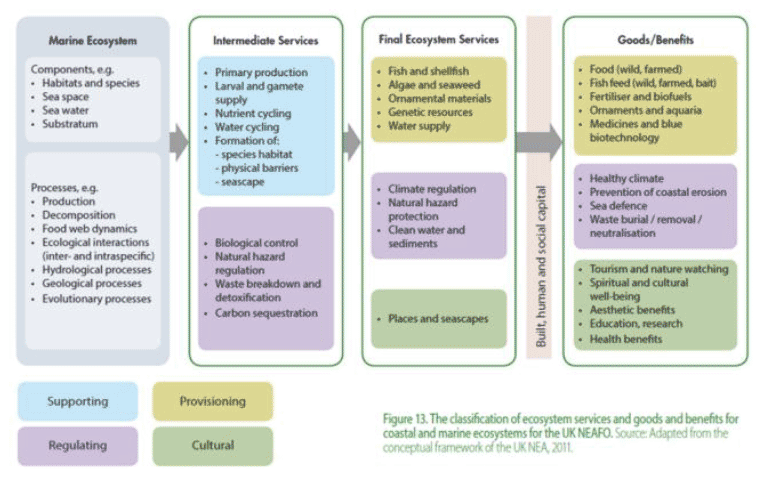
2.2.4 Background on the linkages between the Laws
We needed to identify the role of the law within the scope of the project in order to provide the background for a Law & Policy interlude in the 2 nd Workshop. This was a complex and dynamic process. Firstly, it involved identifying the relevant legal requirements for both the plan making process and the consents/licensing process and some of the laws applicable to various activities carried out in the Firth of Forth. This involved adopting an interdisciplinary approach to the role of law within a wider context and within the role of the project.
The law of the marine environment is vast and extremely intricate. Existing laws are a complex web that spans all levels of governance: local, devolved, national, regional, EU and international. This creates a 'horrendogram' of sectoral legislation and policies. (Boyes and Elliot 2014). A mind map within the framework of the project was created to illustrate the variety of relevant laws (Figure 11).
Figure 11. The 'horrendogram' of sectoral law - please see blow ups of each section in Figures 12-15
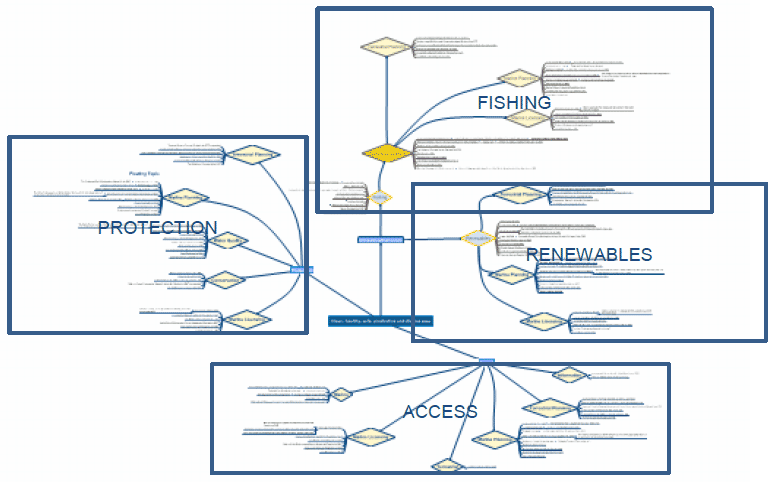
Figure 12. Fishing law
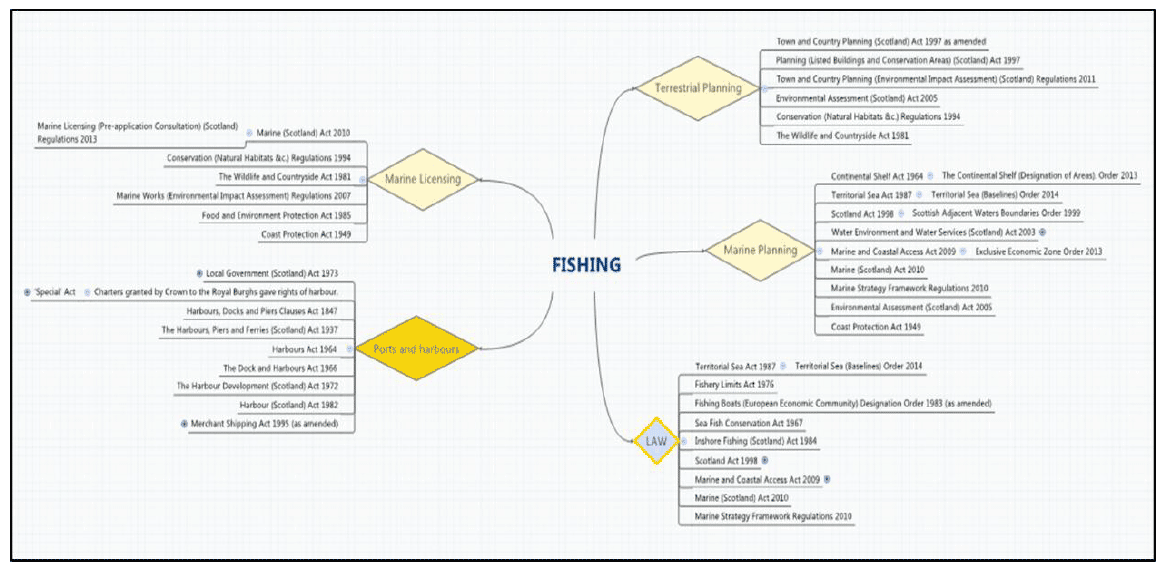
Figure 13. Area protection law
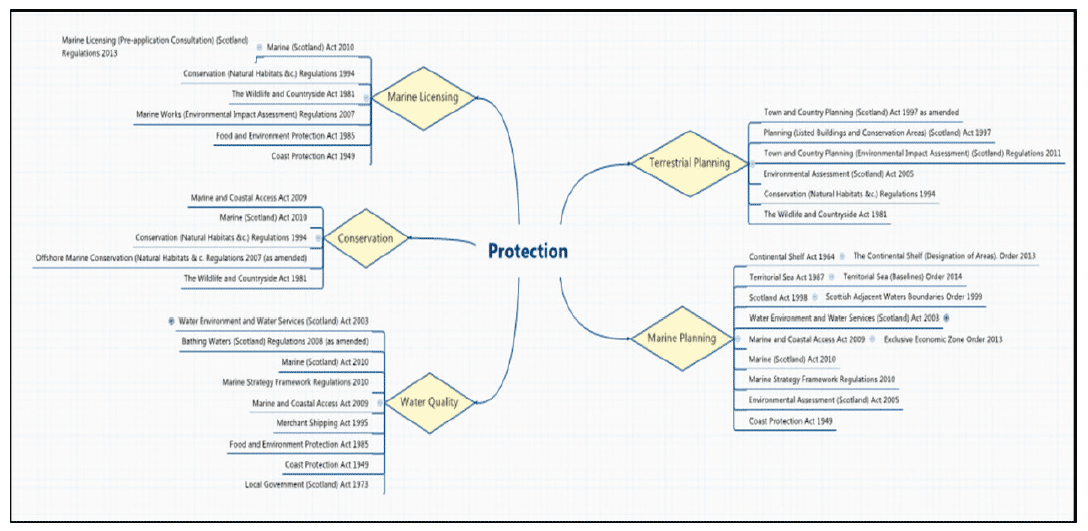
Figure 14. Renewable energy law
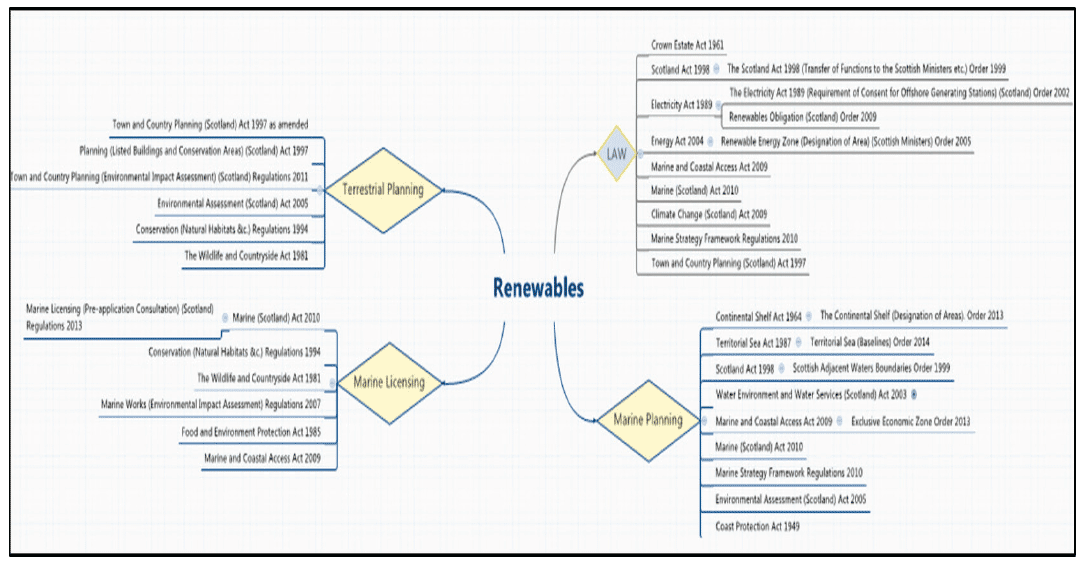
Figure 15. Access law
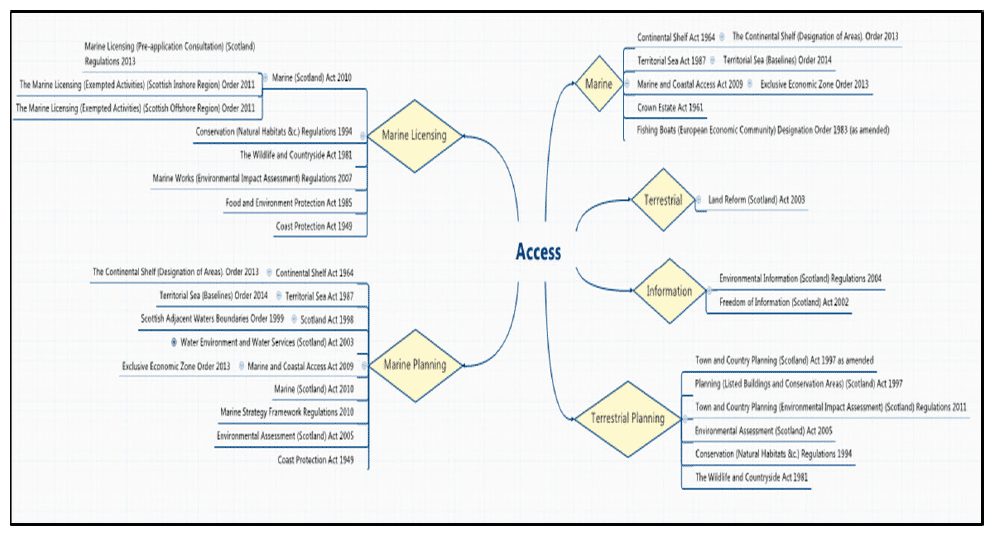
At the Scottish national level, principal legislation is fleshed out with numerous pieces of secondary legislation. In addition to the main primary legislation governing marine and terrestrial planning, numerous other pieces of primary and secondary legislation also apply. For example, the Local Government etc. (Scotland) Act 1994; the Conservation of (Natural Habitats & c.) Regulations 1994 (as amended); the Environmental Assessment (Scotland) Act 2005; and the Freedom of Information (Scotland) Act 2002 (as amended). In order to facilitate integration between the marine and terrestrial planning systems, the Scottish Government has now produced a planning circular explaining the relationship between marine and terrestrial planning policy to assist planners connecting the two different processes (Circular 1/2015, Figure 16).
Figure 16. Policy relationships between marine and terrestrial planning. (Taken from Circular 1/2015)
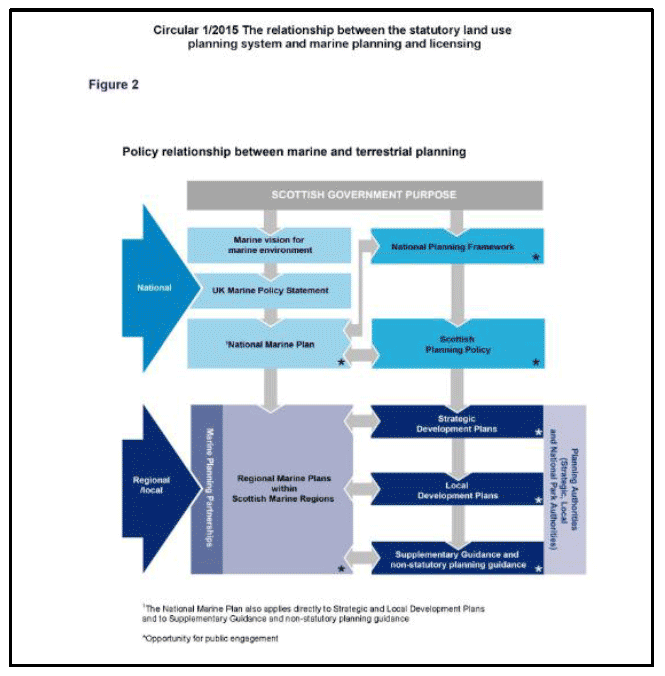
It was noted that law is not confined into specific subject compartments, and that there are interactions between and within the numerous pieces of legislation governing different topics. An example of particular relevance to the project is the decision-making process for renewable energy devices. Within the territorial sea, this is governed by the Electricity Act 1989 and the Marine (Scotland) Act 2010, together with other pieces of legislation that have been executively devolved. This process can be dealt with simultaneously.
Within the United Kingdom, the differences between legislation that derive from the UK Parliament and the Scottish Parliament result in different options being made available to a court when challenges are made. Of note, during the project, a challenge to the s.36 licences granted in the Firth of Forth was raised by the RSPB by way of a Judicial Review action through the Court of Session, and at the time of writing this report a decision was still awaited. Figure 17 illustrates the range of law relevant to the decision making process for marine renewables in the Firth of Forth.
Figure 17. Examples of laws relevant to the decision making process for marine renewables in the Firth of Forth.
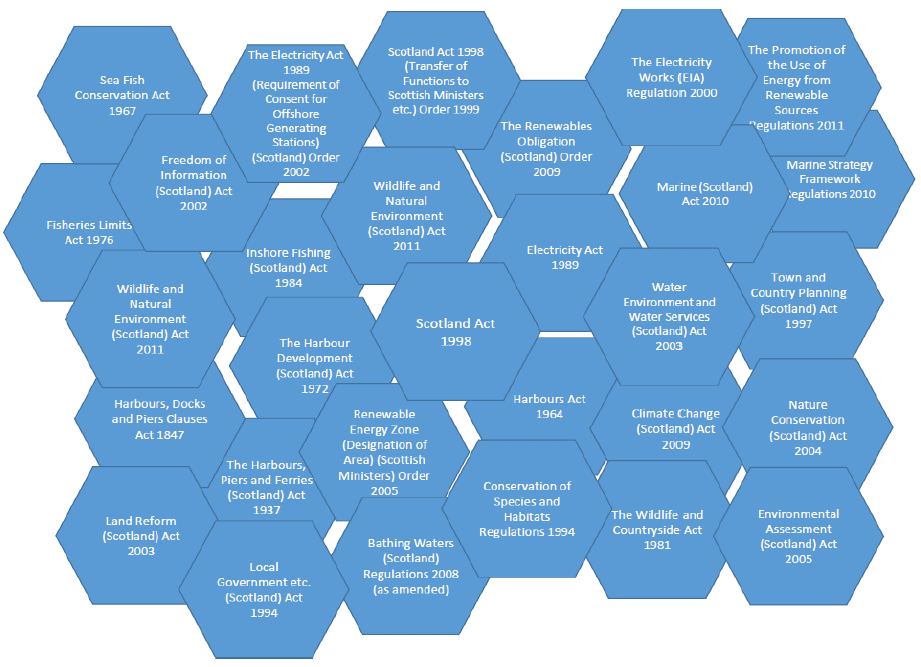
It was also noted that relevant marine policies are the 'material considerations' in the decision-making process. On the one hand, the weight to attach to the policies is for the decision maker to determine, on the other hand, the interpretation of these policies is a matter of law. (Millar Homes Ltd v Scottish Ministers [2015] CSIH 20) (John Watchman 'Policy misinterpretation leads to quashing of reporter's decision' (2015) Scottish Planning & Environmental Law 42)
2.3 Workshop 2
The second workshop took place on the 6th of March 2015 at the Scottish Government Buildings, Victoria Quay in Edinburgh, Scotland. The same stakeholders and representatives from the MRE industry and regulatory/advisory partners were invited to attend the second workshop. The overarching objective of the second workshop was to provide a process to exchange knowledge and deepen understanding around the links between benefits and final and intermediate ES. In reference to Figure 9 (The classification of ES and goods and benefits for coastal and marine ecosystems for the UK NEAFO), the workshop proposed to explore the 'black box' of the relationships between ES and benefits. That is, how do identified services link to and create benefits, how they interact, and how can benefits erode if changes happen within the system. The workshop also explored how the policy system could deal with ES thinking and how individual sectors engage with and affect ES.
The workshop consisted of four stages: (1) Linking Local Benefits to ES, (2) Conceptual System Model ( CSM) Building, (3) Exploring Trade-Offs and Policy Options and (4) Decision-making Process.
Objectives for Workshop 2:
1. To provide a process to exchange knowledge and enhance understanding around links between benefits and final and intermediate ES, where trade-offs arise, and how they might be affected by different policy drivers; and evaluate the effectiveness of this knowledge exchange
2. To consider in what way those trade-offs should be evaluated, and how the decision-making process could be improved to better incorporate these values
2.3.1 Exercise WS2 - 1: Linking Benefits and ES
The objective of exercise 1 was to promote learning about the links between identified ES and benefits including understanding the terms and how they can be used. The exercise provided a chance for participants to re-engage with the material and prepare for a later formal participatory modelling stage (Exercise 2).
| Aim |
To link benefit themes to the three final ES ( ES) and four features of ES as relevant |
|---|---|
| Materials |
Each group was provided with a pre-printed A1 sheet with 3 ES (in centre) and 12 benefits (around the edges and marker pens. |
Activity WS2-1
Each group was provided with a pre-printed A1 sheet with 3 ES (in centre) and 12 benefits (around the edges). The ES were identified from the NEAFO research and deemed most relevant for discussion in the workshop. In addition, we identified a number of 'features' for the ES that would provide additional information on the generic service definitions. This was to contextualise the broad ES definitions into the reality of the Forth region. Benefits were the 12 condensed benefits identified from Workshop 1. The ES and features are listened below. Sitting in groups, now made up of different sectors, the participants were then asked to draw arrows to indicate how benefits link to different ES and their features
ES:
- Fish and shellfish
- Climate regulation
- Seascape
Features associated with each ES:
- Naturalness, wildness and vastness (a)
- Presence of specific species (b)
- Habitats, geodiversity and topography (c)
- Presence of cultural-historic features (d)
Image 4. Stakeholders drawing arrows to show how benefits link to different ES.
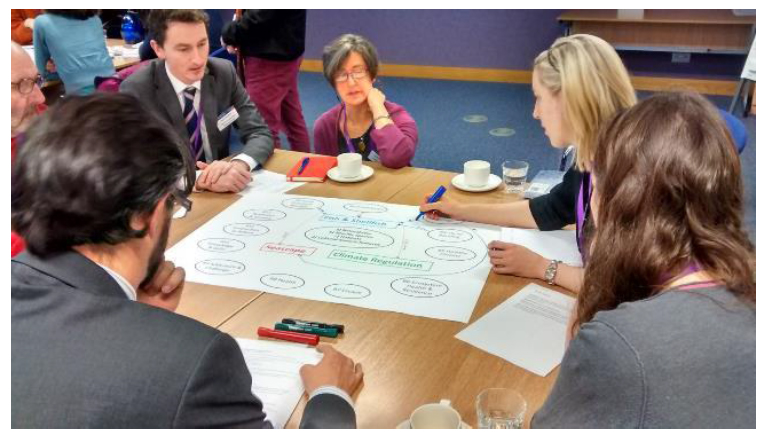
OUTCOMES Exercise WS2-1: Benefit linkages to ES
The 12 Benefit groups and 3 locally important ES and features that were identified from workshop 1 were used in Exercise WS2-1 to assess how stakeholders felt these benefits were linked to the ES. The groups were at each table were identified as Green, Blue and Red Tables.
Figure 18. Proportion of Benefits identified as important - by all tables and separately - number of links
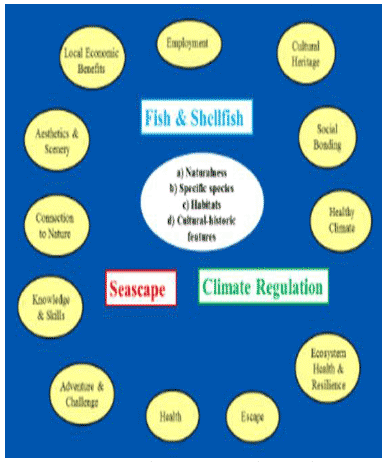
Glossary for the 4 features of ES
Naturalness: Naturalness, wildness and vastness - how natural and wild the environment is perceived to be (without human disturbance / structures at sea i.e. windfarms)
Specific species: Presence of specific species.
Habitats: Habitats, geodiversity and topography - places for animals and plants to live, what it looks like and what materials it is made out of.
Cultural-historic features: Presence of cultural-historic features - wrecks and historic buildings or locations on the coast which are important because of historic or cultural reasons.
Figure 18 and Image 4 show the setup of the A1 sheet provided to stakeholders to draw linkages. Numbers of linkages were counted as each line that was drawn between each benefit type and an ES. The benefits were then grouped into the 4 larger categories and pie charts (Figures 19 and 20 were created to show the proportion of linkages between each of the 3 ES and those 4 grouped benefits.
Figure 19. Pie charts showing a comparison of the links between ES and Benefits of the 4 different benefit categories with all 3 tables (green, blue and red) doing the exercise combined.
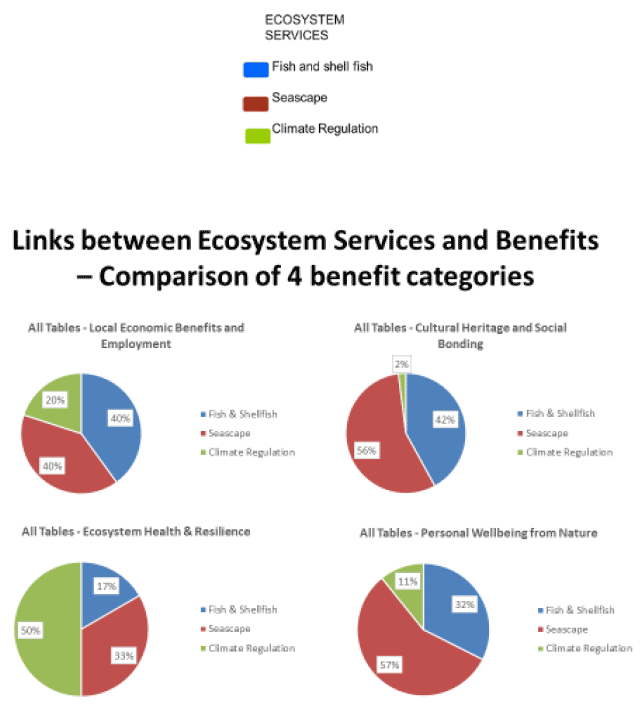
The overall results of quantifying linkages between Benefits and ES (Figure 19) shows that all 3 ES are represented in all of the large benefit groups. There is nearly equal use of all 3 ES in local economic and employment oriented benefits. Almost all the linkages between cultural heritage and social bonding are nearly equally split between Fish and Shellfish and Seascape. Ecosystem Health is predominantly linked to climate regulation and Personal Wellbeing is predominantly linked to Seascape.
Figure 20. The breakdown by individual tables (Red, Blue and Green) of the proportions of linkages between ES and the 4 Benefit Categories.
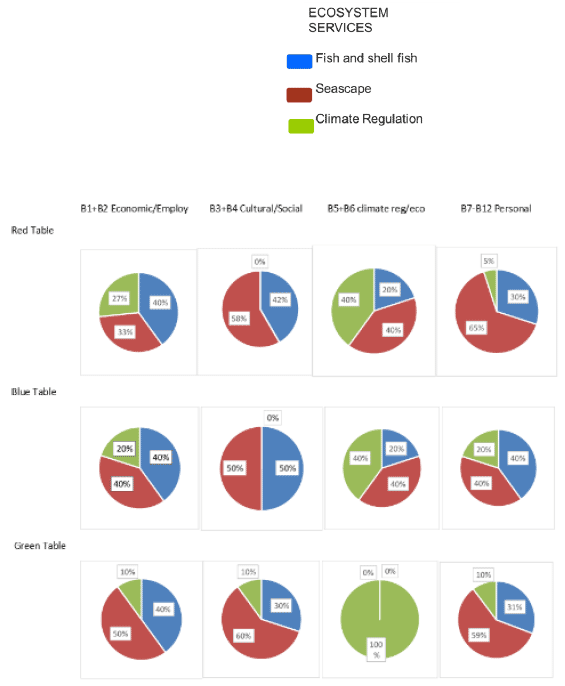
The summarised linkages between ESs and Benefit Categories (Figure 20) show differences between the 3 tables of mixed group stakeholders. There is a high degree of similarity between the Red and Blue tables, but the Green table stands out a being different in the proportion of linkages between benefits and ES. In particular, this table put 100% of the linkages between the ES of Climate Regulation and the benefit of Ecosystem Health and Resilience. One major difference at the Green table that could be identified was a lack of a representative from the Fishing Industry (due to the number of representatives at the Workshop)
Figure 21. Total sum of numbers of links / number of benefit category to show which ES has the most links to benefits ratio.
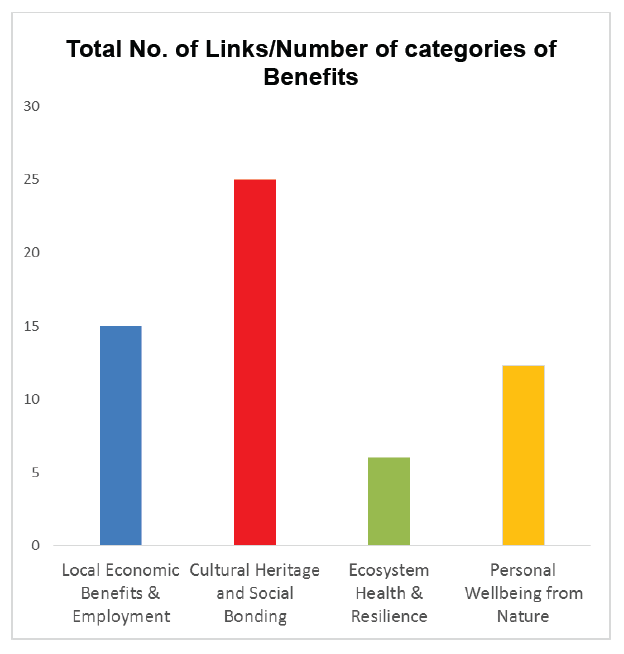
Cultural Heritage and Social Bonding ES received the most links per benefit category (Figure 21) as there was a total of 50 links with just 2 categories of benefits. 74 links joined Personal Wellbeing from Nature, but as there were 6 different benefits represented in that one large benefit category, the number of links per benefit was only 12.3. Local Economic Benefits and Employment had a total of 30 links and Ecosystem Health and Resilience had 12.
2.3.2 Ecological Interlude [see slides www.corporatesproject.co.uk]
This interlude was run to help stakeholders become familiar with the difference between 'intermediate' and 'final' services and 'benefits'. It also contributed to understanding of the importance of different ecological processes in influencing delivery of final services and benefits in preparation for Exercise WS2-2.
2.3.3 Exercise WS2- 2: Conceptual Systems Model Building
The objective of Exercise 2 was to consolidate knowledge of the links between ES, benefits and socio-economic drivers and to identify key relationships and feedbacks to help inform discussion about the impacts of different policy drivers. Each table undertook a participatory exercise in conceptual mapping where a range of connections and feedbacks were identified, discussed and mapped. Developing a participatory conceptual model allows for a group understanding of the social ecological system to emerge, to explore system connections and to emphasise process and learning about services as much as outputs. Stakeholders explored how the connections between ES variables, benefits and actions interacted and changed in the context of the Forth and how these complex systems are woven together.
| Aim |
To develop a conceptual system model around the key ES to look at interactions and feedbacks |
|---|---|
| Materials |
Each group was provided with a sheet of A1 white paper, 17 different ES cards, and marker pens. |
Activity WS2-2
Facilitators put down two first cards and asked the participants if the cards were linked to each other ('+' or '-' or '± 'or '?'). The definitions of relationships included:
- A positive relationship (+) means that if A goes up, B also goes up, whereas if A goes down, B goes down.
- A negative relationship (-) means that if A goes up, B goes down, and if A goes down, B goes up.
- An ambiguous relationship (±) means that if A goes up, in some cases B may go up, and in others it can go down.
- An uncertain relationship (?) means that we don't know what happens to B if A goes up or down.
A sequence of cards was then added to the table, one by one and participants were asked to link the cards either directly or indirectly to the others. At the end of the exercise, participants were asked to focus on the 4 benefits (personal well-being, local economic benefit, cultural heritage & identity, ecosystem health & resilience) and see how these are linked to other parts of the system and what they are dependent on/influenced by.
Table 5: Card Names, colour coding (Ecosystem Services and ES Features, Intermediate Services, Benefits, Actions) and sequence in which to put down cards:
| Term |
Description of Term (Glossary) |
Colour code of circle on card |
Presentation order |
Code for Network analysis |
|---|---|---|---|---|
| Formation of habitats/Habitat Diversity |
The formation of places for animals to live/ a variety of places for animals to live |
Green/Purple Intermediate Services and Ecosystem Services/Features |
1 |
I5 |
| Species Diversity |
A variety of different plants and/or animals |
Purple Ecosystem Services/Features |
2 |
F3 |
| Primary Production & Nutrient Cycling |
The production of food from sunlight and carbon dioxide via organisms ( e.g. plankton) |
Green Intermediate Services |
3 |
I1 |
| Larval/gamete supply |
The supply of organisms for the next generation |
Green Intermediate Services |
4 |
I2 |
| Carbon Sequestration |
The removal and storage of carbon dioxide from the atmosphere |
Green Intermediate Services |
5 |
I3 |
| Climate Regulation & Stability |
The consistency of the timing and expected annual weather conditions within seasons, to lessen the effects of sea level rise and sea temperatures |
Red Ecosystem Services |
6 |
E1 |
| Ecosystem Health & Resilience |
The condition and hardiness of the ecosystem |
Green Intermediate Services |
7 |
I4 |
| Quantity of Fish & Shellfish |
The amount of fish and shellfish |
Red Ecosystem Services |
8 |
E2 |
| Degree of Naturalness, Wildness & Vastness |
How natural and wild the environment is (without human disturbance/structures at sea i.e. windfarms) and the area covered |
Purple Ecosystem Services/Features |
9 |
F1 |
| Number of Cultural-historic features |
Number of e.g. wrecks & historic buildings or locations on the coast which are important because of historic or cultural reasons |
Purple Ecosystem Services/Features |
10 |
F2 |
| Fishing Catch |
The amount of fish caught by fishing boats |
Blue Actions |
11 |
A1 |
| Cultural Heritage & Identity |
Feeling of belonging/social connection to a place and a way of life |
Yellow Benefits |
12 |
B3 |
| Marine Tourism/Recreation |
For example, wildlife boat trips, kayaking, diving, sailing etc. |
Blue Actions |
13 |
A2 |
| Personal Wellbeing from Nature |
Yellow Benefits |
14 |
B2 |
|
| Local Economic Benefits |
Income to the local economy in the form of jobs as well as business earnings or the value of e.g. properties |
Yellow Benefits |
15 |
B1 |
| Offshore Wind Energy |
The effect of having an offshore wind industry: the physical effects of the turbines and the changes to increased human activities, and the changes to local economies |
Blue Actions |
16 |
A3 |
| Number/size of Marine Protected Areas |
The potential for increases in species abundance and biodiversity and the potential changes to spatial fishing practices |
Blue Actions |
17 |
A4 |
Image 5. Stakeholders using the Conceptual System Model to explore interactions and feedback.
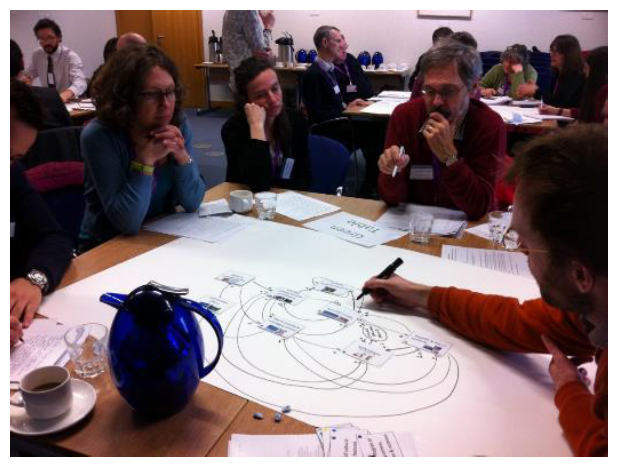
OUTCOMES: Exercise WS2-2 Conceptual Systems Maps - (network mapping/ NodeXL)
The exercise produced both material outputs (i.e maps and data) and outputs that relate to social learning over complex social-ecological relationships between ES, benefits and actions. The conceptual maps produced highlight the complex and detailed interactions in the Firth and increased stakeholder awareness of these interactions. Each of the interactions (ie. the line connecting two variables) was coded into a spreadsheet that formed the basis of a network analysis using the software Node XL. This allowed some of the features of the network to be analysed in terms of key variables, connections and centrality.
Both the participatory conceptual mapping outputs and the network analysis highlight the range of interactions between different services, benefits and actions in the Forth system and the coupled nature of both the social and ecological aspects. The learning from this exercise is covered in the overall review of workshop outputs and helped structure the remaining exercises. However, it should be noted that this exercise was particularly intensive and required considerable focus and energy from the stakeholders, which had ramifications for participation in the remainder of the workshop exercises.
Figure 22. Conceptual System Model trial that the three teams developed in workshop 2.
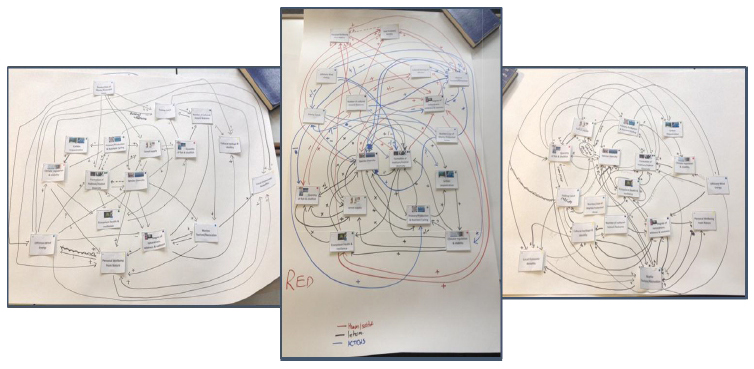
Networks are a means of thinking about the relationships within and between social and natural systems. Nodes are points within networks and can represent individuals, organisations, actors or other entities and are connected together via ties. In this context our nodes are the ES criteria used in exercise WS2-2 and the ties represent the (+)(-)('±') or ('?') relationships between the ES criteria. Networks by their nature are inter-connected and network analysis explores these shared ties between the nodes in the system. Networks are visual representations of the flow of power, resources, information or other currency. In this study, the flows in the network relate to the stakeholder perspectives on the relationships between ES, classifications, benefits and actions. They are not definitive representations of social-ecological systems but conceptual representations of how ES react according to the perspectives of the expert based working groups. Mapping the shape of a network can assist in identifying the flows or blockages of information; the positions of nodes and the relationships between them.
The following network statistics and diagrams were generated using the freely available NodeXL software.
Table 6: The network graph metrics generated by NodeXL selected for the study
| Metric |
Description |
|---|---|
| Total Nodes |
The total number of unique Nodes in each network |
| Edges |
The number of Ties (Relationships) in the network |
| In-Degree |
The total of directed references to a Node which may be a 'Sink' for information, resources or in-bound relationships. High In-Degree values may reflect the power or prestige of a Node in a network and reflect importance. |
| Out-Degree |
The total of directed 'out-bound' references made by the Node which may be a 'Source'. High Out-Degree may reflect high levels of influence. |
| Betweenness Centrality |
A measure of centrality. The more (short) linking paths a Node has within the network then the higher its Betweenness Centrality. A Node with a high Betweenness Centrality may act as an important bridge for information or transfer and as such is assumed to have more power and influence. |
| Eigenvector Centrality |
Seeks to determine the most powerful/influential Actors in the network. It combines the relationship between the Degree of a node and the number of subsequent connections by connected Nodes. A high value reflects the influence of the Node as a function of being central within the network. |
Network analysis utilises a number of statistical metrics based up the position, ties and relationships between nodes (Table 5). Using this approach, we constructed the top 5 ES classes based on measures of in and out degree, betweenness centrality and eigenvector centrality. The results of Exercise 2 were converted into a spreadsheet of relationships. Using the conceptual maps developed by each table (red, blue and green) each connection identified by the participants was isolated and mapped in an Excel database. Each connection between the nodes ( e.g. Card A1 fishing catch to Card F3 species diversity) was categorised according to the (+), (-) or (+/-) relationship. All tables were combined into an overall collective network
Table 7: Top 10 results ordered by Eigenvector Centrality for the combined tables.
| All Tables | ||||||
|---|---|---|---|---|---|---|
| Label | ES Class | Classification | In-Degree | Out-Degree | Betweenness Centrality |
Eigenvector Centrality |
| F3 | Species Diversity | ES/feature | 12 | 11 | 15.432 | 0.081 |
| A1 | Fishing Catch | Action | 7 | 12 | 16.522 | 0.076 |
| F2 | Number of cultural-historic features | ES/feature | 9 | 9 | 9.338 | 0.073 |
| A2 | Marine Tourism/Recreation | Action | 10 | 9 | 6.105 | 0.068 |
| B2 | Personal Wellbeing from Nature | Benefit | 11 | 5 | 6.183 | 0.068 |
| 15 | Formation of habitats | Intermediate ES | 10 | 9 | 6.783 | 0.068 |
| A3 | Offshore Wind Energy | Action | 10 | 10 | 7.469 | 0.067 |
| E1 | Climate Regulation & Stability | ES/feature | 7 | 11 | 13.029 | 0.064 |
| A4 | Number/size of MPAs | Action | 5 | 9 | 4.229 | 0.058 |
| F1 | Degree of naturalness, wildness & vastness | ES/feature | 8 | 8 | 5.017 | 0.057 |
Across the aggregated results of the three tables, 17 nodes were mapped with a total of 343 different connections. Of these connections, 59 were unique and 284 were duplicated or repeated connections. Of the 17 different interactions and feedbacks in the conceptual mapping exercise, the node F3 (Species Diversity: ES / feature) scored the highest in terms of eigenvector centrality and therefore can be considered one of the most central nodes in the network. The node had the highest in-degree suggesting it is considered as an important node for drawing in connections and also the 2 nd highest out-degree (although this is shared with E1 - Climate Regulation) suggesting it is influential within the network in terms of connecting to 11 other nodes in the network. A visual representation is below.
Figure 23. Example from the all tables network highlighting Species Diversity (F3) as a centrally influential node in the network of participant perceptions of interactions amongst select ES.
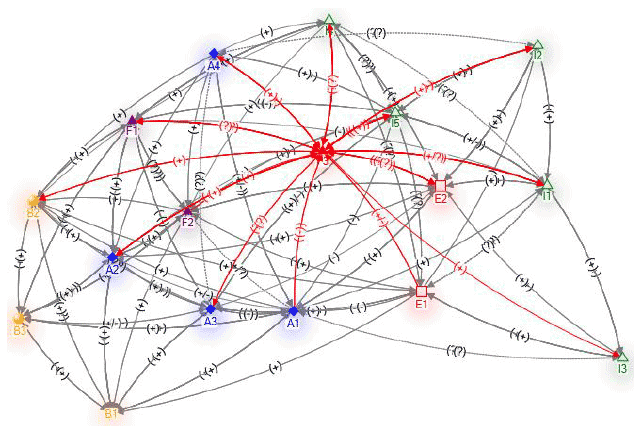
The perception that species diversity is a key variable in the web of relationships around ES in the region highlights the relative importance of the variable in delivering a range of services and benefits. The high score for eigenvector centrality indicates that it is connected to other nodes that have high connections and the betweenness centrality indicates it as an important bridging node within the network. Most services, benefits and actions will interact with species diversity according to the perceptions of combined stakeholder groups. As an example, F3 species biodiversity ( ES / feature) was perceived to have a positive relationship with the variable B2 personal wellbeing from nature (a benefit). This suggests that, according to the range of sectors and stakeholders present, as species diversity increases there is a positive increase in wellbeing effects on individuals and on communities.
Another important variable defined by the participants was A1 Fishing catch (an action variable). This variable was also considered highly central both in terms of links to other connected nodes and to its role as a bridging node in the network. Fishing catch had a high out degree indicating that it was an influential variable connecting to 12 of the 17 nodes and visually represented below.
Figure 24. Example from the All tables network highlighting Fishing catch (A1) as an influential node in the network of perceptions of interactions amongst select ES.
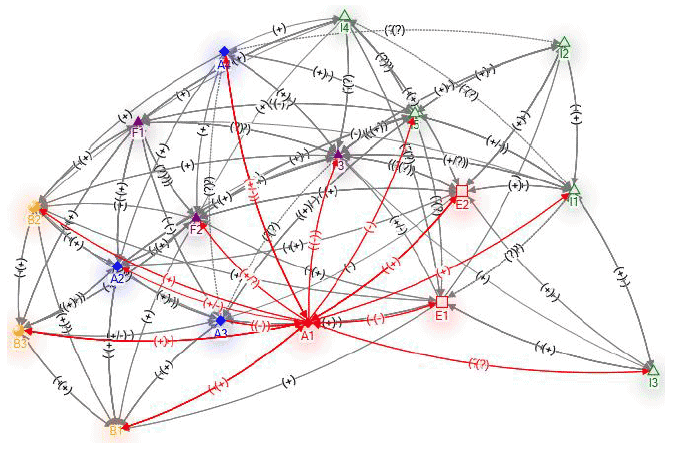
The relationships of fishing catch highlight the negative (-) interaction with F3 species diversity and I5 Formation of Habitats and a positive feedback interaction with B3 cultural heritage, B2 personal wellbeing from nature and quantity of fish and shellfish.
The approach demonstrates that social-ecological systems built around ES interactions are highly dynamic and inter-connected. Variables such as species diversity, fishing catch and cultural diversity are important nodes that connect across the system, according to the perspectives of the range of stakeholders present at the workshop. The network analysis approach is useful for exploring these inter-connections of services and benefits and identifying potential hotspots or key variables in the system.
2.3.4 Law and Policy Interlude
Anne-Michelle Slater and Alison MacDonald (lawyers) prepared a presentation on the law and policy relevant to the project with a focus on explaining that, notwithstanding the complexity of the regulatory and policy context, there was a clear relationship between the law and policy. The presentation also highlighted how the decision support system created in the project could be used to inform the development of marine policy and that the process of marine decision-making could be enhanced even within the existing regulatory framework
2.3.5 Exercise WS2- 3: Exploring Trade-Offs and Policy Options
Working in mixed sector groups, the aim of Exercise WS2-3 was to use the outcome of the previous exercise ( WS2-2), the conceptual system model that the participants had just created, to explore how activities ( MPA, Fishing, Windfarms, Recreation/tourism) will respond to future policy drivers in conservation, fisheries and climate ( e.g. MSFD, Habitats Directive, CFP, IFGs, Renewables Directive, 2030 Climate Framework). The changing actions will have ramifications for different services and benefits and these trade-offs can be explored based on the linkages in the CSM model.
| Aim |
To enable mixed groups to consider how sectors and activities (including industry & conservation) will change in response to key policy and legal drivers and how these changes will impact intermediate ES and benefits. The discussion promotes the connections within the system, the trade-offs that will need to be made, and the potential opportunities and impacts for sectors. |
|---|---|
| Materials |
Each group were issued with a flip-chart with a ready-drawn chart on it and a selected policy driver to discuss. |
Activity WS2-3a
Each group was asked to consider a number of policy and legal drivers and present a set of storylines that represent effects on the actions (wind energy, fishing, MPAs, tourism/recreation) and suggest how these may affect intermediate ES. This helped the groups to advance their understanding of what trade-offs are involved through increasing/decreasing an action in response to policy drivers. The group was also asked to consider the criteria used in decision-making processes. A chart cross referencing drivers with actions / trade-offs was drawn by each facilitator on a flip chart.
Each group was allocated 1 driver to start, and then moved on to discuss another driver. Groups discussed the influence of the following policy drivers:
- Group 1: Conservation ( MSFD; Habitats Directive)
- Group 2: Fisheries ( CFP; IFGs)
- Group 3: Climate (Renewables Directive; 2030 Climate Framework)
- Group 4: Stakeholder suggested drivers
Across the following activities:
- Marine tourism and recreation
- Offshore energy
- Number and size of MPAs
- Fishing catch
Using the conceptual model as guide ( i.e. following the links and +/-), various trade-offs were noted between different activities. As trade-offs were discussed, scribes made notes of any decision-making criteria / principles that emerged.
OUTCOMES: Activity WS2-3a: Trade-offs and policy
For this exercise, each group was asked to consider the impact of a specific policy area ( e.g. fisheries, recreation) on the different elements in the social-ecological system which they had previously mapped out (Exercise WS2-2). With each group focused on a different policy driver, discussions between groups diverged. All groups did however recognise and discuss impacts not only on the sector at which the policy was aimed but also how sector-specific policies might affect other sectors. An example was the potential negative effects of the landing obligation within commercial fisheries on bird species such as gannets which currently benefit from fish discarded from vessels. One of the groups discussed how short and long term impacts of policies could potentially go in opposite directions. An example here was the erection of off-shore wind turbines which was seen as having negative effects on fisheries and tourism in the short term but potentially positive effects in the long term.
A recurring issue was the uncertainty that accompanies the introduction of new policies. New policies can create problems in relation to investments and efforts to comply with existing policies, and uncertainty regarding the exact details and the implementation can in itself be problematic. For example, uncertainty regarding proposed changes in the EU's Common Fisheries Policy was seen to have negative impacts on fishermen already with some people already choosing to leave the fishery sector.
As with an earlier activity that sought to explore potential impacts on the socio-ecological system (Exercise WS1-3), this venture also engendered a degree of confusion and difficulty, although to a lesser degree or extent. The challenge may have been in the design of the activity itself (potentially too many layers) or timing (close to the end of the workshop) although following a second explanation some successful further prompting by facilitators occurred. For one of the groups, the conceptual systems diagram (Exercise WS2-2) appeared to form the basis for discussion whereby individual items within the system ( e.g. fishing catch, tourism) were identified as likely to be impacted by the policy being considered. Their subsequent debate focused on unpacking how this might occur. As a whole, the discussions and insight generated through this activity appeared relatively rich and detailed, which may reflect the emphasis on exploration of linkages and relationships that was central to all activities in Workshop 2. More details of the discussion are given in Appendix 3.
Activity WS2-3B: Individual Narratives of Future Changes
This exercise was created to contextualise the systems model into reality for individuals and their interests. This was done by encouraging the development of 'narratives' for individuals in different sectors. Asking them to reflect on how they respond to the trade-offs discussed in WS2-3A. Do the potential changes from drivers affect their own activity, livelihood, perspective? It was hoped that this exercise would uncover ideas, stories, causes and consequences that could impact decision making, but are missed by the conceptual process.
| Aim |
To develop narratives in order to understand how the conceptual and broad scale issues impact upon individuals. This can reveal new information that supports decision-making and may identify unintended consequences of a policy action. A 'first hand' perspective can improve engagement by making people feel 'listened to' and grounds the conceptual model into the reality of life for the users. |
|---|---|
| Materials |
Each participant was given a sheet of paper and a pen to record their 1 page narrative of future changes. |
Activity WSS2-3B
Within the mixed groups, each individual was given 15 minutes to write up to 1 page a story about how an individual from a sector might respond to the drivers and trade-offs identified in the previous exercise. The following was used as guidance:
- Your story should be about an individual - yourself or imaginary - who is working in a sector in the context of the changing driver.
- What is happening in the broader sector ( i.e. from the drivers) and how does this impact you as an individual? What are your prospects?
- How does your story unfold both in the short term (2020) and the long term (2050)
- How do the changes identified in the system model affect you? Your business? Your values?
- How do you engage in decision-making?
After 15 minutes, the mixed groups discussed their narratives. Facilitators and scribes captured key issues that emerged with a focus on phenomena that can influence the decision-making process.
OUTCOME: Exercise WS2-3B: Individual Narratives of Future Changes
Narratives were, unsurprisingly, varied in structure ( e.g. bullet point list, observational story), content and focus. One commonality voiced in many of the narratives was a recognition of, and concern over the effect of the numerous, varied and seemingly disjointed character of the policy and law contexts. Several such observations are noted in Table 5 as well as the following comment, the content of which provides insight into how a more joined-up policy context might facilitate a different scenario:
Existing dysfunctional regulation currently leading to marine spatial conflict - more integrated regulation would promote MSP - better use of the total resource (for everyone!) [fishing industry participant 1]
Table 8: Comments from participant narratives reflective of the concern over a plurality of policies, laws and budgetary frameworks
| Policy/regulatory drivers in Scotland are very disjointed… Regulatory processes are reactive, largely change coming too late - failure to understand a need to learn from terrestrial planning process [ MRE INDUSTRY sector] No coherent management of several policies may lead to "consultation fatigue" and confusion as to how all of the various policies will fit together [Additional Relevant Stakeholders] Progress on both environmental and conservation issues and on (sustainable) development are hampered by bureaucracy and at the moment it feels like bureaucracy is going off the roof [conservation sector] Policy should seek to drive these by being coherent …we are being snowed under by consultations after consultations [fishery sector] Finance cuts mean consultations being reduced to minimum [community sector] |
Present in the narratives is also a sense of passion and commitment. Two examples of this include:
Personally, I am long past retirement age but feel I can contribute to the future of the industry I have been part of for almost 60 years…[fishery sector participant]
We are at an historic juncture in the development of sustainable marine conservation and planning systems for Scotland's seas. A fundamental question from the perspective of myself (both individually and professionally) is the degree of ambition of the various processes: MPAs and marine planning. [conservation NGO sector participant]
An additional dimension present was that of trade-offs, both in terms of what contributes to the decisions ( i.e. ' outcome of trade-off discussions depends on the scale, particularly temporal scales at which benefits are evaluated', [conservation sector] and the potential for win-win solutions. This latter notion is illustrated by the following two comments:
For me, this is a mixed/complex picture - but we need to see the big picture (spatial plans) to see where (maybe) different activities can exist [community sector]
Opportunities to co-exist are being missed [ MRE INDUSTRY sector]
See Compilation of Narratives in Appendix 4.
Image 6. Stakeholders exploring the trade-offs and policy options.
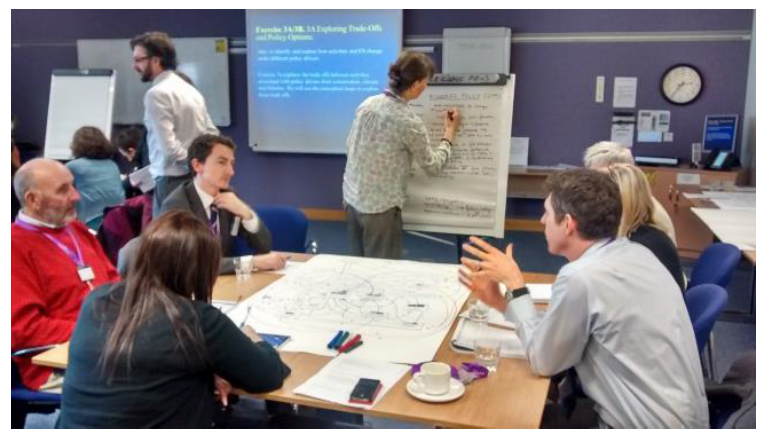
2.3.6 Exercise WS2- 4: Decision-making Process Input
This was a wrap up exercise to allow reflection on both workshops and consider and openly discuss as a whole group.
| Aim |
To reflect on the process (Workshosp 1 and 2) and to provide feedback to inform the parameters of a decision-support tool/mechanism |
|---|---|
| Materials |
Each scribe was issued with a notebook and pen to record the discussions. |
Activity WS2-4
In small groups, participants were asked to discuss the following:
- What elements of the discussions in WS1 and WS2 should be included in the decision-making process?
- How should they be included?
- When? / At what points in the process?
- Who should be involved?
OUTCOME: Exercise WS2- 4: Decision-making Process Input
We have reproduced statements (in italics below) from the discussions and linked them to the exercises that participants have highlighted that they felt should be used in future MSP.
What elements of the discussions in Workshop 1 and Workshop 2 should be included in the decision-making process?
- Gathering of spatial evidence of Benefits (Mapping exercises WS1-1 and Benefits WS1-2)
- Uniqueness of CORPORATES was the introduction of the ES: framework: it is potentially the way forward. (Linking Benefits to ES, WS2-1 and CSM WS2-2)
- A benefit of the workshops highlighted the uncertainty and complexity of the situation (Ecological and Law/Policy interludes and CSM WS2-2)
- It was good qualitative exercise. However, in order for it to be useful and allow decision makers to use, it has to be quantitative and interactions between nodes (represented as arrows) should be modelled. ( CSM WS2-2)
How should they be included?
- Good order of activities: In particular, the gathering of spatial evidence as the first thing (Mapping exercises WS1-1)
- There is always the trade-off on balancing between the benefits to society and benefits to individuals with recognition that benefits to a community are not evenly distributed. (Benefits WS1-2 and CSM WS2-2)
- Uncertainty needs to be included as uncertainty in one sector increases so too does uncertainty in other sectors (Ecological and Law/Policy interludes and CSM WS2-2)
When? / At what points in the process?
- Start now as MSP is very sectoral and socio-cultural aspects are missing.
- Good to use in regional marine planning. Need to have Ecosystem-based regional plans and Cumulative impacts i.e. Pentland Firth & Orkney Waters marine spatial plan
- As other policy drivers conflicting /affecting marine development - need overall view i.e. drivers/policies for MPAs and Climate change have many link to other sectors.
- Too much consultation and not enough actual engagement (listening): listening to stakeholders and trying to find solutions was a two way process.
Who should be involved
- Very beneficial to work with stakeholders from other sectors
- Smaller companies - but individuals do not have time or resources to participate effectively and therefore need a way to be represented
- Government departments - as they were not listening /talking to each other
2.3.7 Workshop 2 - Evaluation Summary
The second workshop had fewer participants (n=14) than initially planned. The breadth of sectors represented however was similar to Workshop 1, although none of the independent tourism operators (recreational sector) were present. This could be a reflection of the time of year (early spring may coincide with preparation for tourist season); it is also reflective of the wider literature in terms of the challenges associated with recruitment of stakeholders to workshops, absence of a financial incentive to participate, and the fact that the process was not aimed at influencing the decision-making procedure in this case.
Assessment of the usefulness of the workshop as well as the workshop materials and delivery were largely positive (Figure 25). From a content perspective, it was noted that the maps generated through the participatory mapping exercise in workshop 1 were missing, with one participant stating, 'there was a disconnection between this and the first workshop.' Across all provided comments there appeared to be an appreciation for the value of such workshops and activities that addressed the complexity and brought together a range of voices. This diversity of sectors and the opportunity to interact with other organisations were both highlighted as contributions to the value of the workshop. These sentiments were coupled with a pragmatic sense of 'now what' which is perhaps exemplified by the following two comments: 'a useful exercise; the challenge remains in translating the complexity into planning' and '[I am] interested to see how you can interpret the outputs from the groups!'
Figure 25. Quality of the workshop 2/out of 1.0
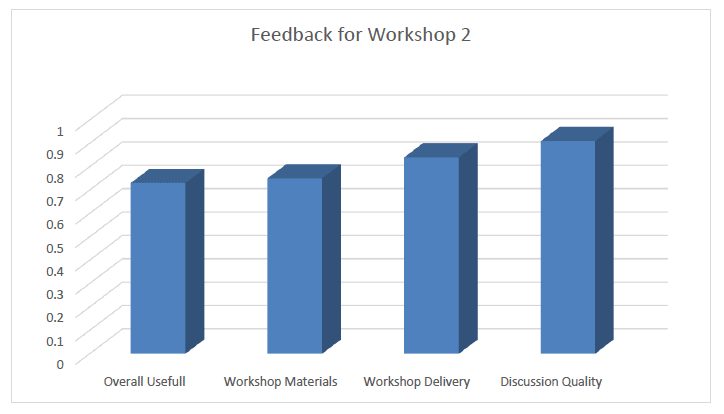
As regards learning about the concepts of ES and trade-offs between different activities, evaluations were mixed with some participants indicating they had learned something new and others stating they had not. This probably reflects substantial differences in prior experience and exposure to ES knowledge. Two participants' comments emphasized the need to fully acknowledge the inherent complexity that is present in these ideas. In considering their responses in relation to learning about these two ideas, one participant wrote: 'but realisation that many relationships are complex - don't feel we bottomed them out fully'. Another noted 'the need for cross-sectoral integration during deliberative processes and to recognize complexities'. Overall responses with regard to knowledge gained about these two concepts is illustrated in Figure 26.
Figure 26 summarises assessment of the extent to which new knowledge was gained from the workshop's specific activities. Evaluations suggested that participants felt they had learned more from the activities that examined linkages and relationships than those focused on trade-offs and impact. Comments from two of the participants suggest that for exercises focused on these latter two areas; there may have been too little time available.
Figure 26. The Percentage of participants that that either agreed or disagreed with the statement that they gained knowledge from the stated activity
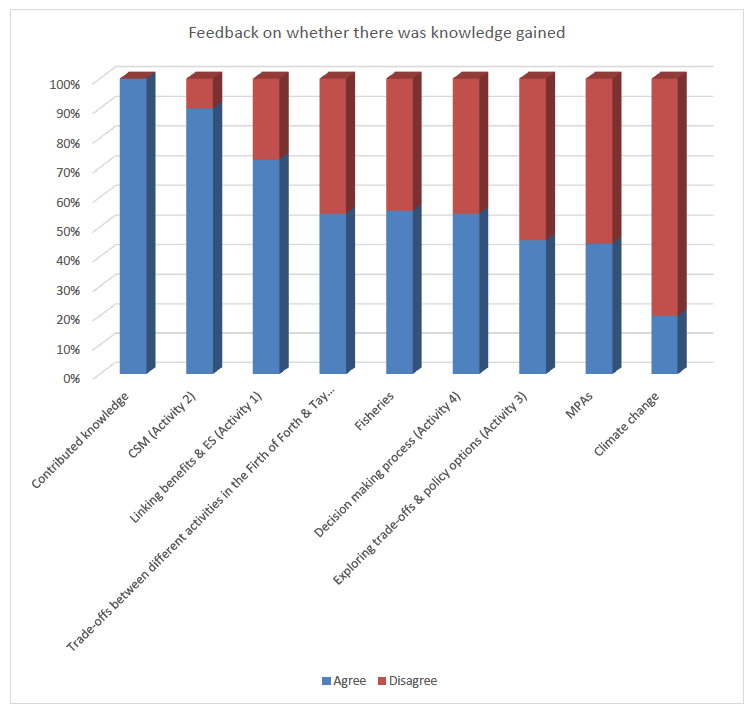
The quality of discussion and opportunity to contribute knowledge or views to discussion were again both rated highly in the evaluation assessment. Participants indicated they liked the opportunity to work in cross-sector groups, valued listening to and interacting with the others and appreciated the personal and social learning opportunity. One individual's comment exemplifies the general sense at the end of the workshop that 'we need to keep the dialogue going'. Importantly, the comment from one of the participants suggests that there was also an appreciation that 'certain aspects did make some participants uncomfortable'. Figure 27 provides examples of summative comments provided by participants for Workshop 2.
Figure 27.Selected stakeholder comments about workshop 2 overall
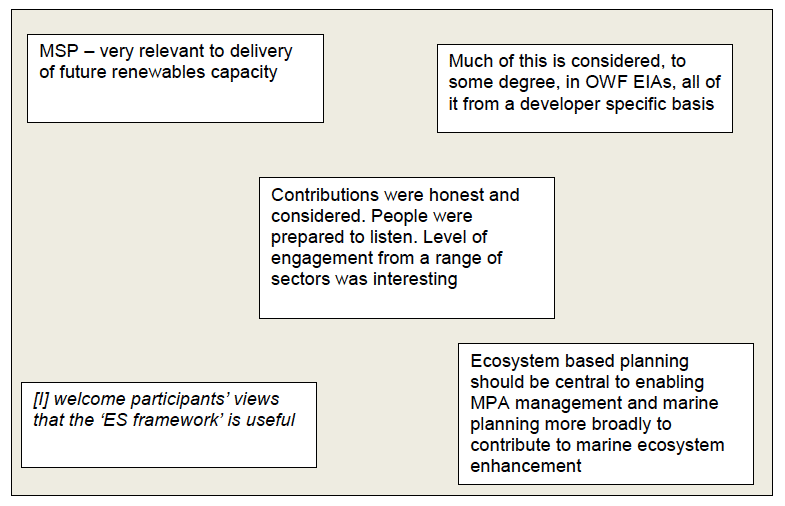
Contact
There is a problem
Thanks for your feedback